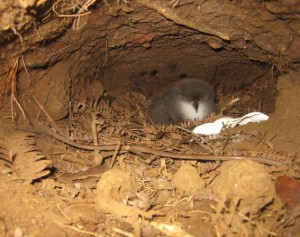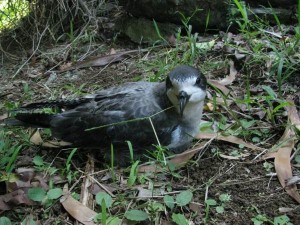Hawai‘i is famous for rare birds: scarlet honeycreepers that dart through the rainforest and gold-flecked owls that hunt at twilight. But another Hawaiian bird lives most of its life at sea. The ‘ua‘u , or Hawaiian petrel, returns to land under the cover of darkness—and then only to nest. Now is the time to be on the look out for this cryptic bird; the chicks are fledging.

An ‘ua‘u chick hides in his burrow awaiting his parents return. In the meantime the chick is vulnerable to passing rats, cats, and mongoose who can quickly scoop the chick from his hiding place.Photo by Jay Penniman
Named for their eerie nighttime call, “uuua-uuuu,” the ‘ua‘u alight on land for only a few minutes before ducking into their underground burrow. Their nesting locations are remote, difficult to access. Counts at sea estimate the population at around 20,000, low enough to earn a place on the Federal Endangered Species list.
Fossils indicate that ‘ua‘u were once so plentiful in Hawai‘i they blackened the sky. Prior to humans’ arrival in these Islands, ‘ua‘u and their feathered friends ruled these Islands. ‘Ua‘u built burrows from the coastline to the mountaintop, digging into soil and taking advantage of existing crevices. But populations have dwindled to a fraction of what they were, due to habitat loss and predation. Now invasive species threaten to overrun the sliver of habitat remaining for native birds, while predators lurk outside their burrows.
Having evolved without mammalian predators, ‘ua‘u are particularly naïve, both in their choice of nesting location and how they rear their young. Ground nesting, even in a burrow, leaves petrel chicks and eggs vulnerable to attacks by stealthy rodents or felines. Pigs, goats, cattle, deer, and people trample burrows, crushing the egg or the chick inside.
‘Ua‘u only lay one egg per season, and both parents invest much energy and effort in rearing the chick. A trip to the grocery store for an ‘ua‘u parent is a two-week, 6000 mile journey along the northwest Hawai‘i an islands to the Aleutians and circling back down to Hawai‘i , among the longest feeding routes of any known seabird. Unfortunately, there is no babysitter; the chick’s safety depends on remaining underground, hidden from predators.
While the species as a whole demonstrates remarkable flexibility in choosing nesting sites—from dense thickets of uluhe fern to frigid cliff faces on the summit of Haleakalā –individual birds are guided by habit. They return to the same burrow year after year, despite the likelihood of a cat laying in wait.
Many people are working to protect the ‘ua‘u . Biologists arelearning more about these remarkable birds by observing their burrows and tracking their movements. A major colony was re-discovered on Lāna‘i in 2006, but the birds’ native habitat was being choked out by invasive trees. To protect this colony, staff from the Lāna‘i Native Species Recovery Program and volunteers are fighting back acres of strawberry guava and replanting the uluhe fern that form a protective blanket over the burrows. Within Haleakalā National Park, park staff controls predators that attack ‘ua‘u .

‘Ua‘u, like this one, are often disoriented by streetlights and end up on the ground. If you find an ‘ua‘u safely pick it up and call the Maui Nui Seabird Recovery Project, (808) 280-4114. Photo by Jay Penniman
You can help as well. When petrel chicks leave the burrow for their first time they can become disoriented by the bright lights of civilization. Some birds come crashing down onto buildings or roads. A grounded chick is defenseless against predators and threatened by cars. If you see a petrel on the ground, carefully pick it up with a cloth or towel and place it in a well ventilated box. Do not try to feed the bird. Call Maui Nui Seabird Recovery Project (808) 280-4114.
By Lissa Fox Strohecker. Originally published in the Maui News, September 9th, 2012 as part of the Kia‘i Moku Column from the Maui Invasive Species Committee.
You can find all the articles in the Kia‘i Moku series http://www.hear.org/misc/mauinews/



Leave a Reply